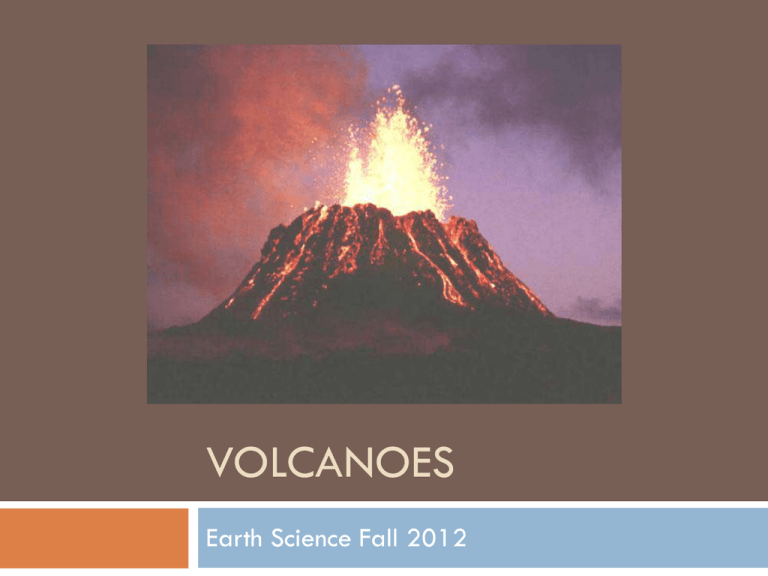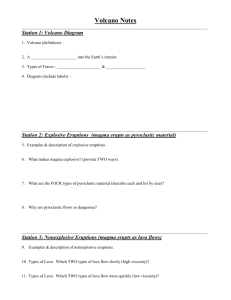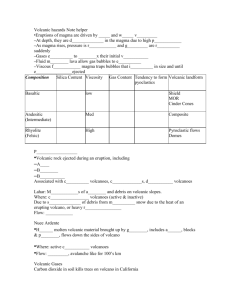Volcanoes
advertisement

VOLCANOES Earth Science Fall 2012 Vocabulary: aa – jagged chunks of lava formed by rapid cooling on the surface of the lava flow Vocabulary: Caldera- large basin-shaped depression formed when an explosion destroys the upper part of a volcanic cone or when the magma chamber below a volcano is emptied during an eruption Vocabulary: Cinder cone- steep sloped deposit of solid fragments ejected from a volcano Vocabulary: Composite volcano- (strato volcano) steep sloped volcanic deposit with alternating layers of hardened lava flows and pyroclastic materials Vocabulary: Crater- funnel-shaped pit at the top of a volcanic cone; bowl shaped depression on the surface of a planetary body Vocabulary: Felsic lava- silica rich lava Vocabulary: Fissure- crack in a rock surface through which lava flows Vocabulary: Hot spot- area of volcanism within a lithospheric plate Vocabulary: Lapilli- pyroclastic particles between 2mm & 64 mm in diamter Lava- magma that reaches the earth’s surface Mafic lava- dark colored rich in magnesium and iron Magma- liquid rock produced deep within the earth Pahoehoe- solidified mafic lava with a wrinkled surface Vocabulary: Pillow lava- lava that flows out of fissures in the ocean floor and cools rapidly in round shapes Pyroclastic material- the rock fragments ejected from a volcano Sheild volcano- has a cone of hardened lava that forms a broad base and slopes gently Stratovolcano- also called composite volcano; steep sloped volcanic deposit with alternating layers of hardened lava flows and pyroclastic material Vocabulary: Vent- opening through which the molten rock flows onto the surface Volcanic ash- pyroclastic particles between 0.25mm and 2 mm in diameter Volcanic block- the largest possible pyroclastic material that is formed from solid rock blasted from a volcanic fissure Volcanic bomb- large, spindle-shaped clot of lava thrown out of a volcano Vocabulary: Volcanic dust- pyroclastic particles that are less than 2 mm in diameter Volcanism-any activity that includes the movement of magma toward or onto the earth’s surface Volcano- lava and pyroclastic material built up on the earth’s surface around a vent Volcanoes & Plate Tectonics Scientists have no direct way to measure temperatures within the earth Analysis of seismic waves & hear flow near the earth’s surface & computer modeling allow scientists to estimate those temperatures Areas of solid rock melt to form magma Forms when mantle material flows to areas of lower pressure faster than it can lower its temperature by hear flow or when fluids such as water are added to the mantle material Volcanoes & Plate Tectonics Volcanism Any activity that includes the movement of magma toward or onto the surface of the earth Pockets of magma form due to melting of some of the surrounding rock More rock melts, magma pockets get large Volcanoes & Plate Tectonics most magma forms at plate boundaries, where one plate is subducted beneath another plate Magma that erupts onto the Earth’s surface is lava The opening through which magma flows to the surface is called a vent The structured formed by the vent and the material that builds up on the earth’s surface around the vent is called a volcano Volcanoes & Plate Tectonics Major Volcanic Zones Most active volcanoes occur in zones near both convergent and divergent boundaries of lithospheric plates Subduction zones Deep trench forms on the ocean floor where the continental crust is being subducted The plate of continental crust buckles and folds, forming a line of mountains along the edge of the continent Volcanoes & Plate Tectonics Magma erupts to the surface at the trench, forming volcanic mountains near the edge of the continent Major zone of active volcanoes is the Pacific Ring of Fire If 2 oceanic plates collide one plate is subducted, forming a deep trench After time a string of volcanic islands forms, called an island arc Island arcs start as small islands and grow to large islands Ex: Aleutian Islands- small islands Ex: Japan – large islands Volcanoes & Plate Tectonics Mid-Ocean Ridges The largest amount of magma comes to the surface at mid-ocean ridges Major zone of volcanic activity Upwelling magma adds material to the mid-ocean ridge & creates new lithosphere along the rift Can also form underwater volcanoes Iceland is located on top of the mid-ocean ridge, it is separated by a fissure Volcanoes & Plate Tectonics Hot spots Areas of volcanism within the interior of the lithosphere Appear to remain stationary, but actually drift slowly; as a result the volcano actually is carried away When the volcano is carried it away, it is moved away from the hot spot and the activity of the volcano comes to an end Hawaiian Islands are an example of a chain of volcanic islands formed over a hot spot Volcanic Eruptions Geologists have concluded that there are two general types of lava: Mafic lava- dark colored when hard and is rich in magnesium and iron Forms much of the ocean crust Felsic lava- contains lots of silica, less magnesium and iron, has a lighter color when hardened Common in continental crust Volcanic Eruptions When mafic lava cools quickly, the surface of the lava flow forms a crust The flow continues move and wrinkles up forming pahoehoe, which means ropey in Hawaiian If the crust is deformed rapidly or grows too thick to form wrinkles, it breaks into jagged chunks to form aa Sharp blocky texture of the volcanic rock Volcanic Eruptions Lava cools so rapidly that the outside hardens leaving a liquid core in the middle, called a lava tube Lava can also flow out of fissures on the ocean floor, it cools rapidly separating into rounded blobs called pillow lava Volcanic Eruptions Kind of Eruptions The composition of the lava that reaches the surface largely determines the force with which a volcano will erupt. Ocean volcanoes, those that erupt on the ocean floor and on oceanic islands, usually are produced by mafic lava Mafic lava is very hot and thin and flows easy Because gases escape quickly these eruptions are very quiet Volcanic Eruptions Felsic lavas of continental volcanoes tend to be cooler and thicker Contain large amounts of trapped gases and when the vent or fissure opens up, the dissolved gases within the lava boil out explosively, sending molten and solid particles shooting into the air Volcanic Eruptions Volcanic Rock Fragments Felsic lava explodes through pyroclastic material into the air Rock fragments ejected from a volcano Some forms when cooling magma breaks into fragments, other forms when a spray of lava cools and solidifies Volcanic ash and dust generally land close the volcano Lapilli are larger than ash and dust and generally land near the volcano Volcanic bombs are formed when large clots of lava harden in the air Volcanic blocks can be a large as a house Volcanic Eruptions Volcanic Features Piles of volcanic material are volcanic cones Types of volcanoes Volcanic cones that are broad at the base and have gently sloping sides are called shield volcanoes Covers a wide area & generally results from lava eruptions Slowly build up Ex: Hawaiian islands Volcanic Eruptions Cinder cones- cause by explosive eruptions Made of solid fragments ejected from the volcano Usually have very steep slopes Rarely more than a few hundred meters tall Composite volcanoes (stratovolcanoes) Are formed by both quiet and explosive eruptions Cone usually formed from lava flows Explosive eruptions deposit lots of material around the vent Cone is made of alternating layers of lava and pyroclastic material Ex: Mount Fuji , Mount Raineer, Mount Hood Volcanic Eruptions Craters & Calderas Craters Formed when material is blown out of the volcano by explosions Usually gradually becomes wider A small cone can form within a crater Caldera When the magma chamber below a volcano is emptied, the cone may collapse, leaving a large, basin-shaped depression Can also be caused by eruptions that discharge large amounts of magma Volcanic Eruptions Predicting Volcanic Eruptions Scientist use measuring devices to detect geologic events that may signal the beginning of an eruption Small earthquakes Result from growing pressure on the surrounding rocks as magma works it way upward Temperature changes within the rock Slight bulging of the surface of the volcano Change in composition of the gases given off by the volcano Study previous eruptions Extraterrestrial Volcanism Many of the planets and moons of the solar system were volcanically active at one time. The Moon Near side is covered with basaltic lava flows Craters on the moon’s lunar surface come from meteorite bombardment Maria – large impacts early in the moon’s history created deep basins that later flooded with lava We don’t know how magma was formed on the moon Extraterrestrial Volcanism Mars There are numerous volcanoes and volcanic features on the surface of Mars Largest volcano on Mars is Olympus Mons. Rise nearly 28 km above the surface 600 km across Caldera is 70 km across We don’t know if the Martian volcanoes are still active Extraterrestrial Volcanism Io Moon of Jupiter 1st planetary body other than Earth where there have been active volcanoes found Probably the most volcanically active body in the solar system The material that erupts from these volcanoes is a bright yellow-red Scietists think that it is primarily sulfur and sulfur dioxide Review Temperature and pressure generally keep the rocks in the athenosphere below melting point. Pink True Yellow False Review Solid rock located deep in the mantle is called magma. Pink- True Yellow- False Review Magma may sometimes break through to the earth’s surface. Pink- true Yellow- false Review Magma is able to rise upward through the earth’s crust because it is less dense than the surrounding rocks. Pink- true Yellow- false







